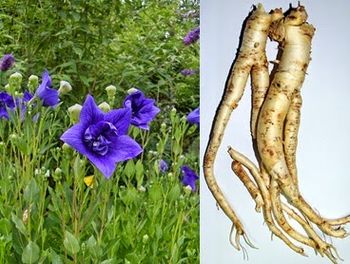Balloon Flower
From Wikiwel
Other Names: Jie-Geng, Platycodon grandiflora, Platycodon root, Chinese bellflower
A hardy perennial featuring star-like, blue-violet flowers. Plants will bloom all summer long.The root of the plant is mainly used as medicine and as a dietary supplement.
See also : Yin Qiao
Special Precautions of Balloon Flower
- Contraindicated in hemoptysis and tuberculosis
- administer only with caution to patients with peptic ulcer.
- Canadian law disallows balloon flower as nonmedicinal ingredient in oral use products (AHP). Health hazards not known with proper therapeutic dosages (PH2).
- Depresses CNS; may be synergistic with other sedatives and CNS depressants.
- Since the herb is hemolytic, should be used orally and not injected (WHO).
- Believed incompatible with Bletilla hyacintha and Gentiana scabra (WHO)
The benefits of Balloon Flower are
- Jie-Geng is a very beautiful vining plant whose edible root has been used in Korean cuisine and to treat ailments of the lung including bronchitis, laryngitis, pleurisy, chest pain and tonsillitis. Platycodon grandiflora has been traditionally used to treat ailments afflicting the lungs and bronchial tubes. Conditions such as bronchitis, laryngitis, pleurisy, heaviness in the chest and tonsillitis.
- For treatment of chest pain due to pulmonary abscess, cough with purulent sputum, it can be used in combination with Rhizoma Phragmitis, Semen Persicae, Semen Benincasae, Herba Houttuyniae, Herba Taraxaci, and other drugs to clear heat and toxins, subdue carbuncle and promote pus discharge.
The edible root can be chopped up fine, put into a tea bag or stainless steel tea ball and steeped for a few minutes in boiled water to make a tea. Honey can be used to improve the taste.
